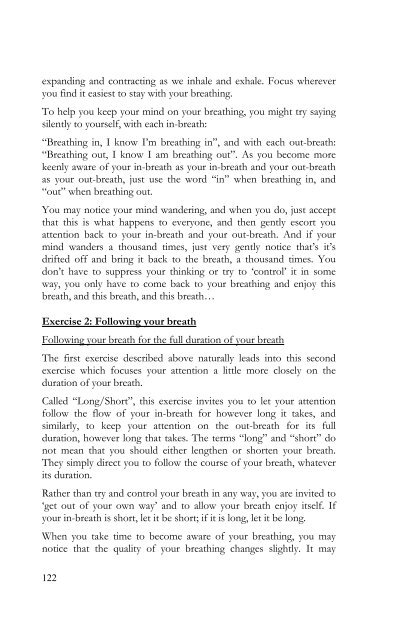Introduction to Mindfulness - Dean Amory
Art and Benefits of Mindfulness Meditation
Art and Benefits of Mindfulness Meditation
You also want an ePaper? Increase the reach of your titles
YUMPU automatically turns print PDFs into web optimized ePapers that Google loves.
expanding and contracting as we inhale and exhale. Focus wherever<br />
you find it easiest <strong>to</strong> stay with your breathing.<br />
To help you keep your mind on your breathing, you might try saying<br />
silently <strong>to</strong> yourself, with each in-breath:<br />
“Breathing in, I know I’m breathing in”, and with each out-breath:<br />
“Breathing out, I know I am breathing out”. As you become more<br />
keenly aware of your in-breath as your in-breath and your out-breath<br />
as your out-breath, just use the word “in” when breathing in, and<br />
“out” when breathing out.<br />
You may notice your mind wandering, and when you do, just accept<br />
that this is what happens <strong>to</strong> everyone, and then gently escort you<br />
attention back <strong>to</strong> your in-breath and your out-breath. And if your<br />
mind wanders a thousand times, just very gently notice that’s it’s<br />
drifted off and bring it back <strong>to</strong> the breath, a thousand times. You<br />
don’t have <strong>to</strong> suppress your thinking or try <strong>to</strong> ‘control’ it in some<br />
way, you only have <strong>to</strong> come back <strong>to</strong> your breathing and enjoy this<br />
breath, and this breath, and this breath…<br />
Exercise 2: Following your breath<br />
Following your breath for the full duration of your breath<br />
The first exercise described above naturally leads in<strong>to</strong> this second<br />
exercise which focuses your attention a little more closely on the<br />
duration of your breath.<br />
Called “Long/Short”, this exercise invites you <strong>to</strong> let your attention<br />
follow the flow of your in-breath for however long it takes, and<br />
similarly, <strong>to</strong> keep your attention on the out-breath for its full<br />
duration, however long that takes. The terms “long” and “short” do<br />
not mean that you should either lengthen or shorten your breath.<br />
They simply direct you <strong>to</strong> follow the course of your breath, whatever<br />
its duration.<br />
Rather than try and control your breath in any way, you are invited <strong>to</strong><br />
‘get out of your own way’ and <strong>to</strong> allow your breath enjoy itself. If<br />
your in-breath is short, let it be short; if it is long, let it be long.<br />
When you take time <strong>to</strong> become aware of your breathing, you may<br />
notice that the quality of your breathing changes slightly. It may<br />
122

















